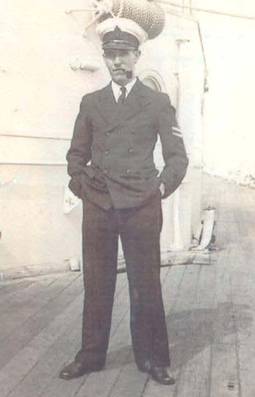- Author
- Swinden, Greg
- Subjects
- History - general, Biographies and personal histories
- Tags
-
- RAN Ships
- HMAS Kara Kara
- Publication
- March 2011 edition of the Naval Historical Review (all rights reserved)
Francis Bassett ‘Dick’ Emms was born at Launceston, Tasmania on 28 November 1909, the eldest of four children of Henry Joseph Emms, a blacksmith’s assistant and tailor, and Stella Marion Emms, nee Batten. Following schooling he worked in his father’s tailoring shop, and also as a wool scourer, before joining the Royal Australian Navy on 14 March 1928.
He undertook initial training as an Ordinary Seaman at HMAS Cerberus and on completion he joined the heavy cruiser HMAS Canberra in March 1929. He served in her until July 1930, during which time the ship operated mainly off the east coast of Australia. He was promoted to Able Seaman in January 1930 and later qualified as a gunnery rating. Although he had been christened as Francis he was known to his shipmates as Richard or Dick, and rarely used his given name.
Able Seaman Emms spent much of the next seven years in the Seaman Branch, which included postings to Cerberus (1930‑31) and the heavy cruiser HMAS Australia (1931-33). The cruiser took part in the normal training exercises off the east coast, coupled with a winter cruise to Queensland and a summer cruise to Tasmanian waters. Australia also circum-navigated the continent in late 1931 and ‘showed the flag’ visiting New Guinea and the Solomon Islands in the latter part of 1932.
Dick Emms married Sylvia Rosetta Tame on 6 January 1932 at St David’s Cathedral, Hobart, and they later had a daughter, Helen Rae, who was born at Tresco Private Hospital in North Sydney on 27 August 1933. In November 1933 Emms was posted to the Sydney depot ship HMAS Penguin and later served in the destroyers HMAS Waterhen (1934) and HMAS Vendetta (1934‑35). In April 1935 he joined the old coal burning cruiser HMAS Brisbane, which was sent to England for scrapping. Her crew then became the commissioning crew of HMAS Sydney (II). Dick Emms then served in Sydney (II) from September 1935 until April 1937.
Posting as a Cook
It was in 1936, while serving in the Middle East in Sydney (II), working with the Royal Navy, that his eyesight began to deteriorate, and rather than leave the Navy he was offered the chance to transfer to the Supply Branch. In January 1937 he underwent a short cookery course at Cerberus to assess his suitability, and on 9 February 1937 he was re-rated as a Cook (Officers). Emms was then posted to the destroyer HMAS Stuart in April 1937 and served in her until June 1938, during which time the ship operated off the east coast of Australia. Dick Emms was promoted to Acting Leading Cook (Officers) in April 1938.

Image courtesy of RAN
Following service in Stuart he was posted to the sloop HMAS Swan (1938-39) and the depot ship Penguin (1939-40) where he was confirmed in the rank of Leading Cook. He served again briefly in Canberra during 1940. In September 1940 Dick Emms was posted to the Darwin shore depot HMAS Melville where he was employed as a cook at the base, and in the boom defence vessels which operated the world’s largest anti-submarine boom in Darwin harbour.
Japanese Attack on Darwin
On 19 February 1942 Leading Cook Emms was serving onboard the boom defence vessel HMAS Kara Kara when the Japanese conducted their first air raid on Darwin. During this raid dozens of Japanese aircraft attacked ships in the harbour, the RAAF airfield, and bombed the city indiscriminately. Eight ships were sunk, dozens of aircraft destroyed, nearly 200 people were killed and many others seriously injured. During the attack Kara Kara was singled out by several Japanese aircraft which commenced strafing the vessel. Emms manned one of the ship’s machine guns and returned fire, and continued to do so even after he had been seriously wounded. His constant and accurate fire forced the Japanese aircraft to break off their attack and probably saved the lives of several of his shipmates.
Dick Emms was badly wounded as a result of the attack and died while being transferred to the hospital ship HMAS Manunda. He and several other men killed were buried at sea later that evening, although several people who died onboard Manunda were buried ashore in a mass grave.
Medals and awards
Leading Cook Emms was subsequently awarded a posthumous Mention in Dispatches: ‘…for continuing to fire his machine gun although mortally wounded, thereby probably saving the ship and many of the ship’s company’. Many of his shipmates believed he should have been awarded the Victoria Cross.




